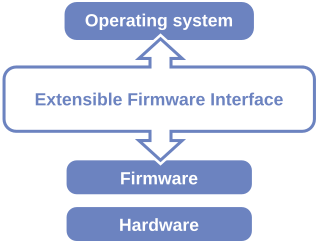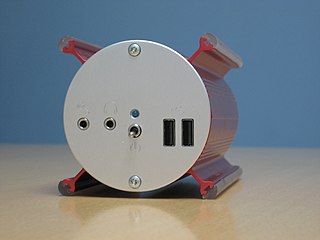In computing, booting is starting up a computer or computer appliance until it can be used. It can be initiated by hardware such as a button press or by software command. After the power is switched on, the computer is relatively dumb and can read only part of its storage called read-only memory (ROM). There, a small program is stored called firmware. It does power-on self-tests, and most importantly, allows accessing other types of memory like a hard disk and main memory. The firmware loads bigger programs into the computer's main memory and runs it. In general purpose computers, but additionally in smartphones and tablets, optionally a boot manager is run. The boot manager lets a user choose which operating system to run and set more complex parameters for it. The firmware or the boot manager then loads the boot loader into the memory and runs it. This piece of software is able to place an operating system kernel like Windows or Linux into the computer's main memory and run it. Afterwards, the kernel runs so-called user space software – well known is the graphical user interface (GUI), which lets the user log in to the computer or run some other applications. The whole process may take seconds to tenths of seconds on modern day general purpose computers.

Open Firmware, or OpenBoot in Sun Microsystems parlance, is a standard defining the interfaces of a computer firmware system, formerly endorsed by the Institute of Electrical and Electronics Engineers (IEEE). It originated at Sun, and has been used by Sun, Apple, IBM, ARM and most other non-x86 PCI chipset vendors. Open Firmware allows the system to load platform-independent drivers directly from the PCI card, improving compatibility.
A boot sector is a region of a hard disk, floppy disk, optical disc, or other data storage device that contains machine code to be loaded into random-access memory (RAM) by a computer system's built-in firmware. The purpose of a boot sector is to allow the boot process of a computer to load a program stored on the same storage device. The location and size of the boot sector is specified by the design of the computing platform.

GNU GRUB is a boot loader package from the GNU Project. GRUB is the reference implementation of the Free Software Foundation's Multiboot Specification, which provides a user the choice to boot one of multiple operating systems installed on a computer or select a specific kernel configuration available on a particular operating system's partitions.

Multi-booting is the act of installing multiple operating systems on a computer, and being able to choose which one to boot. The term dual-booting refers to the common configuration of specifically two operating systems. Multi-booting may require a custom boot loader.

The Unified Extensible Firmware Interface (UEFI) is a specification that defines a software interface between an operating system and platform firmware. UEFI replaces the Basic Input/Output System (BIOS) firmware interface originally present in all IBM PC-compatible personal computers, with most UEFI firmware implementations providing legacy support for BIOS services. UEFI can support remote diagnostics and repair of computers, even with no operating system installed.

coreboot, formerly known as LinuxBIOS, is a software project aimed at replacing proprietary firmware found in most computers with a lightweight firmware designed to perform only the minimum number of tasks necessary to load and run a modern 32-bit or 64-bit operating system.
RedBoot is an open-source application that uses the eCos real-time operating system Hardware Abstraction Layer to provide bootstrap firmware for embedded systems. RedBoot is used in both product development and in deployed products in the field, such as the entertainment systems on the Airbus A380s and Delta's Boeing 767.
Das U-Boot is an open-source, primary boot loader used in embedded devices to package the instructions to boot the device's operating system kernel. It is available for a number of computer architectures, including 68k, ARM, Blackfin, MicroBlaze, MIPS, Nios, SuperH, PPC, RISC-V and x86.
OpenBIOS is a project aiming to provide free and open source implementations of Open Firmware. It is also the name of such an implementation.
A proprietary device driver is a closed-source device driver published only in binary code. In the context of free and open-source software, a closed-source device driver is referred to as a blob or binary blob. The term usually refers to a closed-source kernel module loaded into the kernel of an open-source operating system, and is sometimes also applied to code running outside the kernel, such as system firmware images, microcode updates, or userland programs. The term blob was first used in database management systems to describe a collection of binary data stored as a single entity.

ThinCan is the name for a thin client manufactured by Estonian electronic design start-up Artec Group. The ThinCan remained relatively unknown outside Estonia until 2006, when a recent ThinCan iteration was selected as the hardware base for the Linutop, a network appliance that greatly stimulated the market for lightweight computing platforms. The ThinCan was also commercialized by SmartLink under the Revnetek brand name.
LOBOS is a software program that allows remote booting ("netbooting") of a personal computer without using a BIOS. It allows one kernel to boot another kernel. LOBOS is part of an effort to move away from fixed, proprietary BIOSes to systems that allow more adaptability, especially with different physical peripheral devices.
AMD Generic Encapsulated Software Architecture (AGESA), is a bootstrap protocol developed by Advanced Micro Devices (AMD), used to perform the Platform Initialization (PI) on mainboards using their AMD64 architecture. The AGESA software in the BIOS of such mainboards is responsible for the initialization of the processor cores, memory, and the HyperTransport controller.
A master boot record (MBR) is a special type of boot sector at the very beginning of partitioned computer mass storage devices like fixed disks or removable drives intended for use with IBM PC-compatible systems and beyond. The concept of MBRs was publicly introduced in 1983 with PC DOS 2.0.

SeaBIOS is an open-source implementation of a 16-bit x86 BIOS, serving as a freely available firmware for x86 systems. Aiming for compatibility, it supports standard BIOS features and calling interfaces that are implemented by a typical proprietary x86 BIOS. SeaBIOS can either run on bare hardware as a coreboot payload, or can be used directly in emulators such as QEMU and Bochs.

Libreboot is a free-software project aimed at replacing the proprietary BIOS firmware found in most computers with an open-source, lightweight system designed to perform only the minimum number of tasks necessary to load and run a modern 32-bit or 64-bit operating system.
Librem is a line of computers manufactured by Purism, SPC featuring free (libre) software. The laptop line is designed to protect privacy and freedom by providing no non-free (proprietary) software in the operating system or kernel, avoiding the Intel Active Management Technology, and gradually freeing and securing firmware. Librem laptops feature hardware kill switches for the microphone, webcam, Bluetooth and Wi-Fi.

LinuxBoot is a free software project aimed at replacing most of the DXE modules in UEFI firmware with the Linux kernel. LinuxBoot must run on top of hardware initialisation software in order to start. This can be the PEI part of UEFI, coreboot, or U-Boot.










